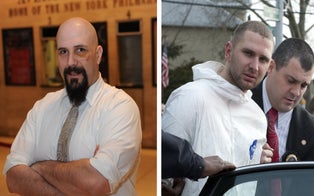Karina Vetrano was 30 years old when she was attacked, strangled and sexually assaulted in 2016.
The murder of Chanel Lewis, the New York man accused of killing Karina Vetrano in 2016, has ended in a mistrial.
After a day and a half of deliberations, the jury returned Tuesday night to the courtroom split on whether to find Lewis guilty of the murder and sexual abuse of Vetrano, a 30-year-old avid runner who went for a jog one summer evening two years ago and never came back.
Vetrano was an avid runner who often took to the paths near her family’s Howard Beach home with her father, a retired firefighter. But Philip Vetrano didn’t go with his daughter on Aug. 2, 2016, opting to stay behind because he was nursing an injury.
When Vetrano didn’t return home and didn’t answer her phone, her father called the police.
First responders and Vetrano’s father took to Spring Creek Park, where he knew his daughter would have passed, to look for her.
As Philip combed through the tall grass and sunflowers on the side of the running path, he discovered his daughter’s body. It was as if she meant for him to make the gruesome discovery, he later said.
“She needed me to find her. ….She led me to her, she needed her daddy to find her, no question about it,” he told Newsday.
Vetrano’s body was found face-down 15 feet off the path. She had been strangled, her teeth were broken and she suffered scrapes to her legs. She had been clutching grass, indicating she had been dragged, and her clothes had been partially removed.
“This woman put up a ferocious fight right to the end,” then-Chief of Detectives Robert Boyce said. Vetrano’s brutal slaying rocked the community and made national headlines, as investigators quickly determined her killing was random.
"We believe there's a severe community threat, as you know,” Boyce told reporters three days after Vetrano’s murder.
Detectives scoured the area in which Vetrano was found, searching in 300-foot increments for clues. They also appealed to the public to come forward, offering a reward that ultimately reached $35,000 for information leading up to an arrest. A GoFundMe page created by Vetrano’s family reached $290,000, with $250,000 of the money raised to go toward the reward for information about her killer. The rest was to be donated to charity.
“We plan to chop down just about every weed in that location till we’re satisfied that we’ve got all the evidence,” Boyce said. “This is a remote area. A young lady was running — still daylight — so hoping somebody saw something going into the park.”
Authorities were able to recover DNA from under Vetrano’s fingernails, from her back and on her phone. DNA was present at multiple places at the crime scene as well. But for months, police were unable to find a match in any databases.
On Aug. 31, police released a sketch of a person of interest in the case, saying the man had been spotted by a utility worker on the pathway to the Belt Parkway on the north end of Spring Creek around the time Vetrano was killed. On Sept. 12, "Crime Watch Daily" released home surveillance footage of Vetrano running near Spring Creek Park, minutes before she would be killed.
In December 2016, the FBI and NYPD shared a profile they developed of the person they believed responsible for Vetrano’s death.
After following more than 250 leads, police on Feb. 5, 2017 arrested Chanel Lewis, a 20-year-old from East New York in Brooklyn who graduated from a high school for “children experiencing emotional and behavioral problems.”
Authorities said Lewis’s DNA matched the DNA found under Vetrano’s nails, on her back and on her phone. Police said Lewis confessed during a 12-hour-long police interview, allegedly saying, “I beat her to let my emotions out.”
Lewis’s arrest came after NYPD Lt. John Russo suggested police look into him for the Vetrano case. Russo had first noticed Lewis walking around the neighborhood in March 2016 and believed him to be “suspicious,” according to The New York Times. He saw Lewis in Howard Beach the next day and called the local precinct. Five officers stopped and frisked Lewis, who was then released.
After being pointed toward Lewis, police said they uncovered a series of calls he placed to emergency responders as a teenager in which he said he “wanted to hurt girls.”
It was then they requested a DNA swab. Lewis pleaded not guilty to 13 counts of murder and sexual abuse. His family remained by his side and argued he was innocent.
"My son is friendly, God-fearing and would not hurt anybody,” Lewis’ mother, Vita, told reporters last year.
Lewis’ attorneys said police had rushed to make an arrest to appease the public.
“It was going nowhere. They were starting to get, I don’t want to use the word desperate but they needed to prove this,” Robert Moeller told the Wall Street Journal. “They wanted to solve this case. So along comes somebody and, oh, the profile fits.”
They also argued that none of the evidence against him should be admissible since they all were “the direct fruit” of an unlawful stop-and-frisk that was the result of racial profiling. But a judge ruled in February 2018 that all evidence against Lewis was admissible in court.
Lewis’ trial began Nov. 5. Vetrano’s family had vowed to be in court every day.
"We are there to stand for my daughter, who cannot stand for herself," Philip told ABC News ahead of the trial.
Lewis’ interrogation tape was played for the court on Nov. 9. In it, Lewis can be heard telling police he got angry with Vetrano when she tried to fight him off.
“I was beating her and was mad at her,” Lewis said.
He told police he punched her five times and then dragged her “by the hands” into the tall grass. There “I finished her off,” he said.
At one point Lewis claimed Vetrano had drowned, as if by accident. He also said said he never sexually assaulted Vetrano.
“I didn’t do any of the other stuff they said,” he said. “Sexual assault and other stuff.”
During another taped interrogation with prosecutors, Lewis can be heard saying he hurt his hand on Vetrano’s teeth when he punched her. Prosecutors showed jurors hospital records from the day after Vetrano’s murder that showed Lewis was treated for “a classic boxer’s injury” on his hand.
“I never really meant to hurt her, it just happened,” Lewis also said.
After allegedly confessing to the crime, police said Lewis asked to see Vetrano’s photo. NYPD Det. Christian Quezada testified during a preliminary hearing that she was transporting Lewis to central booking when he made the request.
"During the ride he asked me if the victim’s family was watching on the news, and he asked me if he could see a picture of her,” Quezada testified, Fox News reported at the time. “I said, 'No.'”
After nearly two weeks of graphic testimony, closing arguments were made Monday.
“We can all agree that what happened to Ms. Vetrano was horrible. … What is at issue here is whether the police arrested the person responsible for committing [her killing],” Moeller said.
Moeller said Vetrano’s father “corrupted” the crime scene by holding his daughter’s body after discovering her.
Assistant District Attorney Brad Leventhal said in his closing statements that there was no doubt that Lewis was responsible for the beating, strangulation and sexual abuse of Vetrano.
“[Lewis] went to the park — Spring Creek Park. It was that fateful day that he came across Karina Vetrano jogging,” Leventhal said, the New York Post reported. “He was angry, he was mad, and he took out his anger on Karina Vetrano, grabbing her, beating her, throwing her to the ground and strangling her until she was dead — his words.
“His DNA is on her phone. His DNA is on her neck,” Leventhal continued. “The DNA under her fingernails belongs to [Lewis] and Karina Vetrano. I promised you the evidence in this case would be overwhelming and I have kept that promise as well.”
The jury in its deliberations requested a number of key pieces of evidence presented, including the DNA evidence and interrogation tape. But they ultimately returned deadlocked, telling Justice Michael B. Aloise they did not believe their split conclusion would change.
“I’m inclined to believe them,” Aloise said as he granted the defense lawyers’ request for a mistrial.
Vetrano’s family reportedly declined to speak as they left the court. Attorneys for Lewis pointed to the jury’s inability to convict as proof that they were correct in saying the case was not a slam dunk.
“As we have said since day one, this case is far from conclusive and the jury’s deadlock proves this,” the Legal Aid Society said in a statement to CBS New York. “The death of Karina Vetrano is tragic and our hearts go out to her family, but the rush to criminalize our client is not the answer, nor is it justice. We will continue to fight on behalf of Chanel Lewis at the retrial in January.”
Lewis remains in custody, as the Queens District Attorney’s Office said it plans to retry the case. A new trial will begin Jan. 22. If convicted, Lewis faces 25 years to life in prison.
But there's little closure to be had for Vetrano’s family, who have spoken about the struggle they undergo each day in contending with their loved one’s brutal slaying.
“There are no better days, there aren’t any worse days, they are all the same,” Philip told Newsday in July of 2017.
He has taken to creating a memorial for his daughter near where she took her last breath, creating a garden he visits twice a day to think about her.
Vetrano was a speech pathologist who earned a master’s degree from St. John’s University the May before she was murdered.
She had begun working with children with autism and also worked at a local catering hall.
"She lived more in her short 30 years than most people do in 10 lifetimes," Philip told ABC News.
Vetrano loved to travel and had taken trips to Europe and to Egypt, where she rode camels by the Great Pyramids.
"She had a bucket list at 26 years old and she actually accomplished and did most of those things on the list," he said. “She went everywhere ... nothing stopped her. She was extraordinary.
"She always enjoyed herself," he continued. "It should be an example to others to live your life, live every day as if it's your last day. Because you don't know what 10 minutes from now is going to bring you. And that's how Karina lived her life."
RELATED STORIES





